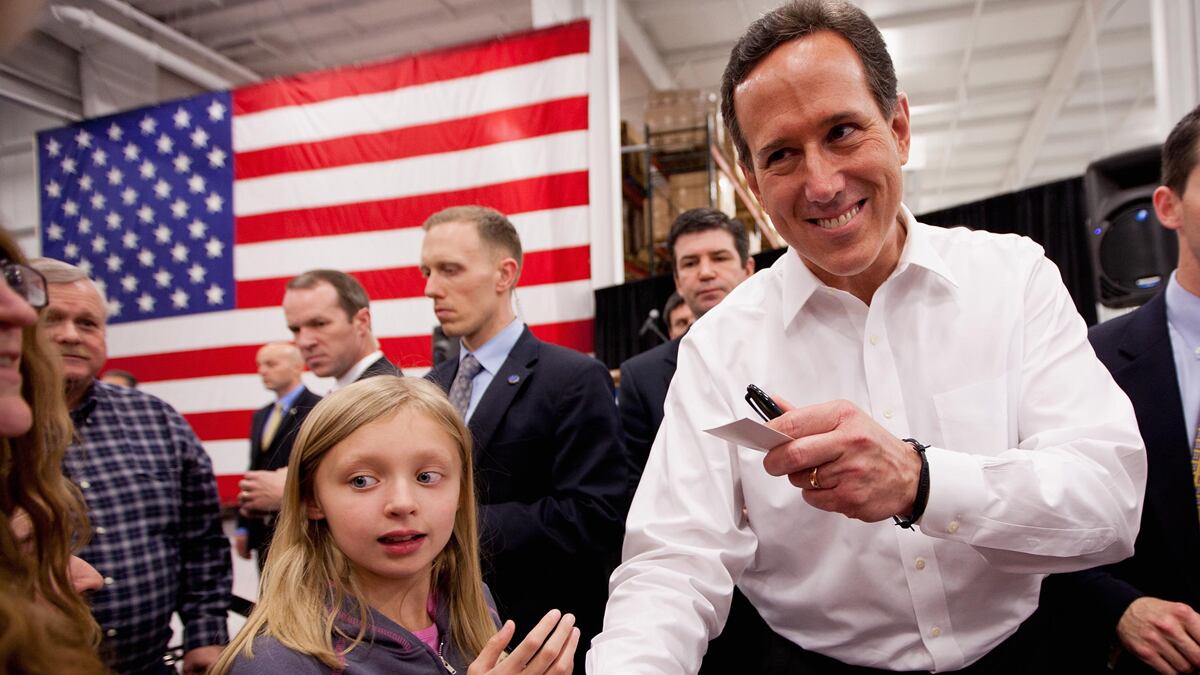Not all of them are “clinging to guns and religion,” as Barack Obama famously said in 2008, but Rick Santorum has catapulted to the top of the Republican field by connecting with a bitter streak among rural voters. This is bad news for the Republican party and for rural America, which in fact has some pretty good reasons to be optimistic.

Urbanites, Santorum told South Carolinians in January, have “a whole different value structure…They’re not going to be participating in small-town life. They’re not going to be connected to mainstream America or to God and his creation.”
Those voters have returned the contempt, with Mitt Romney consistently winning in larger metropolitan areas. Rick Santorum, by contrast, has from his campaign’s modest beginnings in the small towns of Iowa drawn the bulk of his support from the least-populated counties.
ADVERTISEMENT
“I kept saying, you just stick with us, you go out and vote for your values and trust what you know,” Santorum said after his victory in the Kansas caucuses in March. “Because you don’t live in New York City. You don’t live in Los Angeles. You live like most Americans in between those two cities, and you know the values you believe in.”
Santorum—who last I checked lived in swank, suburban Washington—has become the candidate of rural and small-town inertia, representing the isolated, aging, often modestly educated and overwhelming white residents nostalgic for a fading past. The Santorum worldview, following a tradition that well precedes Sarah Palin, portrays a wholesome, small-town middle America fighting a desperate battle against corrupt coastal big-city “elites.”
The problem for the party if he somehow emerges as the Republican nominee is that most voters live in metropolitan areas. Just 16 percent of Americans live on farms, small hamlets, and villages. The problem for those rural Americans is that Santorum’s campaign of complaint appeals to and reinforces the worst stereotypes of rural life, while overlooking the brighter future already emerging in much of the hinterland.
Rural America, particularly the vast region known as the Great Plains, appears to be on the verge of an economic and cultural renaissance. I live in Los Angeles, but have witnessed a remarkable change in both on the ground reality and mood during numerous visits to and studies of rural areas over the past decade. When I first starting going to Fargo, North Dakota, it seemed just a listless prairie town; today it is full of high-tech firms and boasts a downtown bustling with a vibrant, youthful population of attractive, largely Nordic revelers.
To be sure, many small towns in the Plains and elsewhere are shrinking and some will disappear entirely in the coming decades. But larger towns like Fargo, Bismarck, Sioux Falls, Omaha, as well as many smaller ones, now boast the strongest economies in the country—with low unemployment and strong job and income growth. Most of these cities enjoy positive in-migration not only from the rural hinterland, but from the densely packed coastal areas. The Plains’ population growth is already outpacing the national average, and is even further ahead of the urban core cities so celebrated in the media.
Santorum seems to have missed something in his travels back in time. He may appeal to an imagined, largely self-contained rural Eden—but he’s mostly ignored the global economics that have fueled the rural resurgence.
Start with the basics: the production of food and fiber, which is fundamental not only to the Plains but to the Midwest, central California and the cotton-growing regions of the Southeast, Arizona, and west Texas. It’s the global demand for these products that has created good times in small towns. In 2011, the U.S. exported a record $135 billion in food and fiber, with a net positive balance of $47 billion, the highest in nominal dollars since the 1980s. Santorum as a senator opposed NAFTA and now talks about engaging in a trade “war” with China. Yet developing countries constitute rural America’s fastest-growing market. Many nations lack the water and land resources to feed themselves at a higher per-capita level of consumption; Beijing has acknowledged this by effectively dropping the old Maoist goal of self-sufficiency.
Foreign investment flows have also benefited rural communities, particularly in the Southeast and the Plains. Firms are investing in critical sectors such as manufacturing and energy that benefit rural communities. Industrial investment rose $30 billion just between 2009 and 2010, while investment in the energy sector more than tripled to $20 billion.
Japanese, German, and Korean manufacturers are primary players laying the foundation for a rural and small-town resurgence across the long-suffering rural Southeast. Last year, Mercedes, whose largest U.S. plant is in Tuscaloosa, Ala., invested $350 million in the facility. Arch competitor Volkswagen last year announced it will build a new assembly plant in Chattanooga, Tenn. Nissan, Toyota and Kia have all announced major new plant openings or expansions in the region, mostly in small rural towns (and, it’s worth mentioning, in “right-to-work” states that don’t allow closed union shops). When Toyota recently announced plans to establish a plant for the Prius near Tupelo, Mississippi (the birthplace of Elvis), they received 35,000 applications for 1,300 positions.
At the same time, increased fossil-fuel demand in global markets has sparked energy giants from China, France, and Spain to take up stakes in fields in Ohio, Mississippi, Colorado, and Michigan. A smart, globally minded Republican would be pushing these investments, which are already creating boom from North Dakota to south Texas. President Obama’s urbane academician’s obsession with subsidizing renewable energy and barely disguised disdain for fossil fuels represents a threat to the continued prosperity of many rural communities and small towns.
Critically, Santorum’s regressive social views—his tone of resentment as much as the particulars—belies the kind of openness needed for a full-scale rural revival. In the real world, rural America is becoming increasing diverse and dependent on immigrant labor.
Plains towns like Grand Island, Nebraska, are filling up with Mexican or Honduran restaurants. The percentage of foreign-born Nebraskans has more than tripled since 1990. The GOP electorate in the Cornhusker State may be overwhelmingly white, but the demographic trends suggest this won’t always be the case—so long as the party can avoid alienating these new arrivals.
In many places Hispanics constitute the major counterforce to wholesale depopulation. Every county except one in the western half of Kansas suffered depopulation of non-Hispanic whites during the past decade, while Hispanics have offset or even exceeded the decline in white population—filling schools and opening businesses in the process. Hispanic residents have pushed from hubs like nearby Dodge City, Garden City, and Liberal into ever smaller communities, buying property on the cheap, enticed, many say, by the opportunity to live quiet lives in communities more similar to those in which they were raised.
Of course many people—notably some of the older white voters flocking to Santorum—are hostile to these realities. And in the short run, appealing to anti-immigrant sentiments may pay off in the Republican primary. But over time, if they are to survive, many rural communities will either adjust to diversity or simply disappear.
But perhaps the worst betrayal of rural America lies in denying the aspirations of these places to shed off the historic isolation and overdependence on natural resources that have long dogged them. Santorum may consider a college education “elitist,” and see public schools as akin to “factories,” but in many parts of the Great Plains and elsewhere excellent public schools are cherished by Republicans and Democrats alike. A core competitive advantage of many rural states lies in their surplus of highly educated young people. Students in Nebraska, the Dakotas, Montana, and Idaho tend to perform better in school than those in more metropolitan ones (as measured by graduation rates, college attendance, and enrollment in upper-level science and education programs).
These educational advantages are being bolstered by in-migration now tilted toward younger families seeking opportunity, affordable housing, greater social cohesion and better schools. And with generally stronger fiscal balance sheets, due largely to the booming agriculture and energy sectors fueled by international demand, many rural states are expanding their public university systems even as states like California are cutting theirs.
By appealing to perceived deficiencies in rural communities, Rick Santorum downplays all these positive forces. Much of rural America is already booming, and, connected by the Internet, investment, and trade, can play an important role in the American future. Appealing to nostalgia about a past fading into history is not the way to get there.






